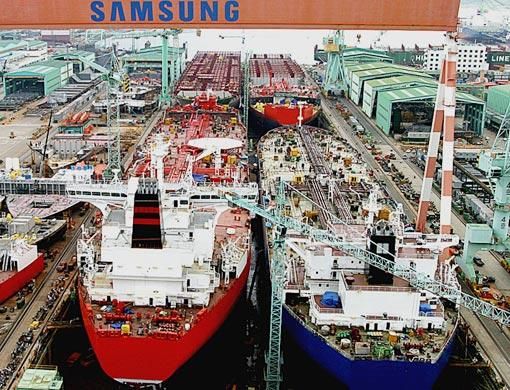Seoul: Samsung Heavy Industries Co will deliver the world's biggest liquefied natural gas tanker to ExxonMobil Corp's venture in Qatar in August, adding capacity to the market for the cleaner-burning fuel.
The tanker, Mozah, named after the wife of the Emir of Qatar, will supply gas to customers in the US and the UK at lower costs, C.H. Park, executive vice president for project planning, said yesterday in Busan, a port city where Samsung was contracted to make 11 tankers, each of 266,000 cubic-metre capacity.
"The vessel can hold almost twice the amount of LNG as conventional tankers while it can save 30 per cent of transportation costs," said Park, clad in a grey workman suit that's worn by the 15,000 workers at the yard. "Overall, it's 50 per cent more cost-efficient than a traditional tanker."
Qatar, the world's biggest LNG producer, has ordered 45 LNG tankers from three Korean shipyards, each capable of carrying more than 200,000 cubic meters. The ships include 31 tankers of 209,000 cubic-metre capacity, known as the Q-Flex, and 14 Q-Max vessels, of which Mozah is the first.
The price of a Q-Max increased to $400 million currently from $300 million in 2005 when Samsung's yard was booked for the ship because steel and raw material prices have risen, Park said. A Q-Max holds enough LNG to power South Korean households for more than two days.
Global LNG consumption is set to increase 10 per cent a year through 2015, more than five times the estimated gain in crude oil demand, Citigroup Inc. said in a report in April.
In addition to the existing 270 LNG tankers, there are orders for 118 new ships still to be built and 29 have been delivered this year, Debbie Turner, director of LNG at BS Energy Services Ltd, a broker, said in an interview from London on Monday.
For Samsung, the world's second-largest shipyard, LNG vessels account for 30 per cent of revenue, Park said. Mozah took 15 months to build after the company cut steel in April 2007 and will be named on July 11.
The Q-Max, which is about the size of four football fields, can load only at Qatar's Ras Laffan port and dock at specially built import terminals, one of which is operated by the South Hook LNG Terminal Co. in the UK and is scheduled to open this year, Turner said. South Hook is a venture between Qatar Petroleum, Exxon and Total SA.
"There is a very good chance that this will dominate the trade from Qatar to the UK or the US," said Luis Benito, manager, Korea Business Development Team, at Lloyd's Register Asia, which inspects and certifies ships. "The ship is designed for the long-haul trade."
Equipped with slow-diesel engines that work more efficiently than steam turbines, these super-sized tankers burn less fuel and produce 30 per cent less emissions compared with a typical tanker, Park said.
The Q-Max has a re-liquefaction plant that returns evaporating gas back to the storage tanks, maximising the fuel cargo at the discharge port. Traditional tankers typically lose 0.15 per cent of cargo a day during a voyage.
Qatar, which overtook Indonesia in 2006 to become the world's biggest LNG exporter, plans to expand capacity to 77 million metric tons by the end of the decade, accounting for a third of the world's supply in 2010.
The nation is building six LNG production lines, or trains, of 7.8 million tons each, about twice the size of a typical train, Qatar Petroleum, the biggest shareholder in the LNG projects at Ras Laffan, said on its website.













